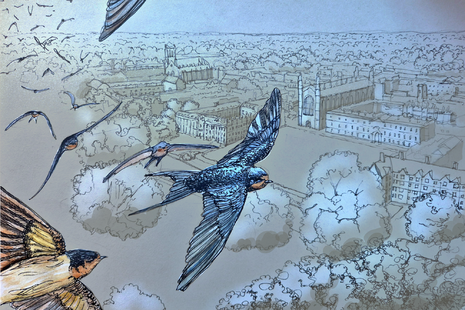Science
Unlocking Quantum Computing Insights from Migratory Birds

Understanding the migratory patterns of birds could offer significant insights into the development of quantum computing. As autumn approaches, the melodic songs of swallows and swifts in places like Cambridge give way to the sounds of redwings and fieldfares, signaling the start of migration. Approximately 20% of the world’s bird population migrates to warmer climates during winter, a phenomenon that has intrigued humans for centuries.
While early thinkers like Aristotle speculated about the transformations of species during migration, modern science has uncovered that birds utilize a combination of visual cues, genetic coding, and a unique sense known as ‘magnetoreception’ to navigate thousands of miles from the UK to Africa and back. Birds primarily rely on their sight, using geographical landmarks and the stars to orient themselves. Notably, they navigate similarly to sailors by referencing the rotation of stars around the North Star.
Genetic factors play a crucial role in migration patterns. Birds whose parents possess differing migration routes often take an intermediate path. Research indicates that their first migration is critical, as it establishes a lifelong route. To retrace their journey each year, birds use their sense of smell to recognize familiar locations.
The concept of magnetoreception remains partially mysterious, yet recent studies suggest it may have quantum properties. There are two leading theories regarding how birds detect the Earth’s magnetic field. One theory posits that birds contain crystals of magnetite, a magnetic iron mineral, which align with the magnetic field. This theory, however, faces challenges regarding the size of the crystals and their ability to function within biological tissues.
A more promising hypothesis, proposed by Klaus Schulten in 1978, suggests that magnetoreception involves quantum mechanics. The theory describes how covalent chemical bonds can break in two ways—heterolytically or homolytically. The latter results in the formation of free radicals, which have unpaired electrons that possess a property known as ‘spin’. When free radicals form with antiparallel spins, their state can switch rapidly, influenced by the Earth’s magnetic field. This mechanism may explain how birds are able to sense magnetic fields, potentially involving a light-sensitive molecule found in their eyes, such as cryptochrome 4.
Researchers are increasingly focused on studying bird migration to inform the development of quantum computers. The intricate navigation skills of birds might inspire new technologies capable of processing information in fundamentally different ways.
In addition to their remarkable navigation, scientists are also examining how some birds manage to survive on minimal sleep. Research shows that many songbirds can function effectively with ‘micronaps’ that do not compromise physiological processes. The U.S. Defense Advanced Research Projects Agency (DARPA) has invested in initiatives to analyze the neural circuits of migratory birds, with the aim of exploring the possibility of creating soldiers who require less sleep.
Despite the fascinating adaptations of migratory birds, their journeys face new challenges. Man-made structures and artificial light pollution are increasingly disrupting their migration patterns. A 2022 study indicated that bird species diversity was lower in areas with wind turbines, suggesting that infrastructure impacts the distribution of migratory species negatively. Additionally, artificial lighting at night can mislead night-migrating birds, causing them to fly in circles and increasing their risk of collisions with buildings, as well as depleting their energy reserves.
As we observe swallows beginning their long journeys to Africa or redwings arriving from Scandinavia, it becomes clear that the study of these remarkable birds holds the potential for significant technological advancements. The ongoing research into migratory birds not only enriches our understanding of nature but also paves the way for future innovations in quantum computing and beyond.
-

 Health3 months ago
Health3 months agoNeurologist Warns Excessive Use of Supplements Can Harm Brain
-

 Health3 months ago
Health3 months agoFiona Phillips’ Husband Shares Heartfelt Update on Her Alzheimer’s Journey
-

 Science2 months ago
Science2 months agoBrian Cox Addresses Claims of Alien Probe in 3I/ATLAS Discovery
-

 Science2 months ago
Science2 months agoNASA Investigates Unusual Comet 3I/ATLAS; New Findings Emerge
-

 Science1 month ago
Science1 month agoScientists Examine 3I/ATLAS: Alien Artifact or Cosmic Oddity?
-

 Entertainment5 months ago
Entertainment5 months agoKerry Katona Discusses Future Baby Plans and Brian McFadden’s Wedding
-

 Science1 month ago
Science1 month agoNASA Investigates Speedy Object 3I/ATLAS, Sparking Speculation
-

 Entertainment4 months ago
Entertainment4 months agoEmmerdale Faces Tension as Dylan and April’s Lives Hang in the Balance
-

 World3 months ago
World3 months agoCole Palmer’s Cryptic Message to Kobbie Mainoo Following Loan Talks
-

 Science1 month ago
Science1 month agoNASA Scientists Explore Origins of 3I/ATLAS, a Fast-Moving Visitor
-

 Entertainment2 months ago
Entertainment2 months agoLewis Cope Addresses Accusations of Dance Training Advantage
-

 Entertainment3 months ago
Entertainment3 months agoMajor Cast Changes at Coronation Street: Exits and Returns in 2025









